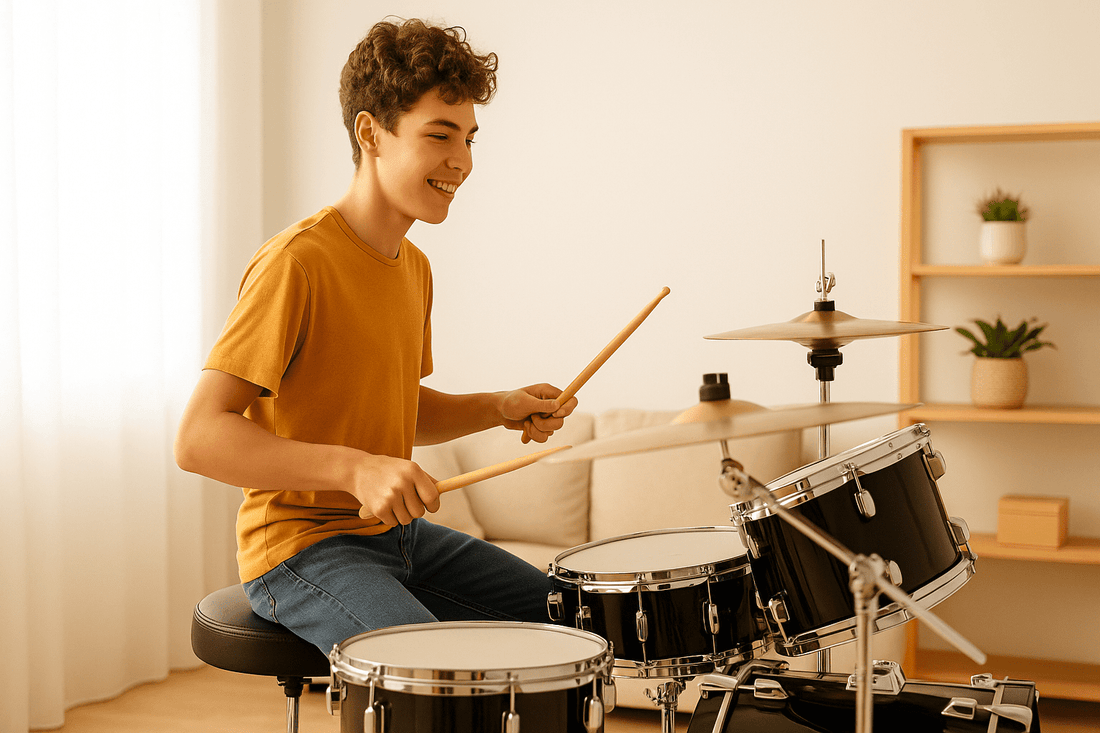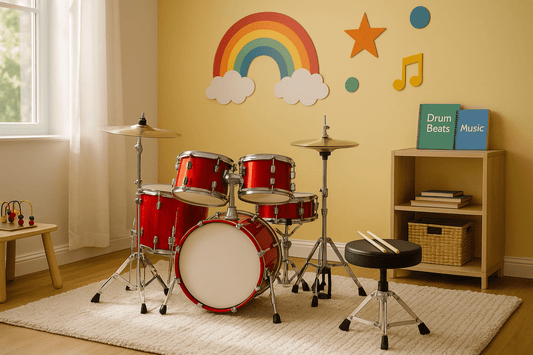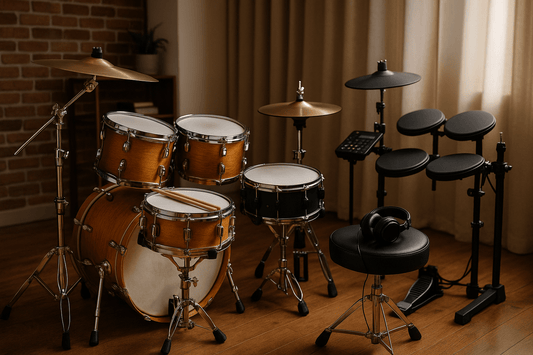If you're just starting out on your drumming journey, you're probably fixated on sticks, snare, toms, and cymbals. Maybe you're dreaming of your first flashy kit or tweaking your technique to sound more pro. But there’s one piece of gear that gets overlooked all the time—your drum stool, also called your drum throne. Sounds boring, right? Think again. This humble seat could make or break your entire experience as a drummer.
Whether you’re playing at home, practicing for your school band, or jamming with friends in the garage, your posture and comfort matter. A lot. The stool you sit on while playing has a direct impact on how well you play, how fast you improve, and even how long you can play without pain. In short, it’s just as critical as any tom, snare, or pedal in your kit.
Let’s break it all down and show you why you need to stop ignoring your stool—and start treating it like the MVP it really is.
Understanding the Role of a Drum Stool
What Is a Drum Stool (or Throne)?
Before we go deep, let’s clear one thing up—yes, “drum throne” sounds dramatic, but it’s just drummer lingo for your stool. And it’s more than just a fancy word. It’s your command center. Think about it: you’re seated for every beat you play. Every time you hit a snare, crash a cymbal, or slam a bass drum, you’re relying on that seat to keep you stable, balanced, and grounded.
A drum throne is usually round or saddle-shaped and height-adjustable. Some are super padded, some spin, and some are rock solid. The key difference between a regular chair and a proper drum throne? A drum stool is designed to support movement—side to side, up and down, and all around.
And while it may not make sound like your drums do, it does something just as important: it allows you to control your entire body while playing.
More Than Just a Seat: The Hidden Importance
Here’s the thing—if your stool is too high, too low, too hard, or too soft, it messes with your whole setup. You start leaning too far forward. Your arms overextend. Your feet lose contact with your pedals. Eventually, your technique suffers, and you feel it in your back, hips, and knees.
That’s why experienced drummers invest in good thrones. They understand that sitting right is the foundation of everything. For beginners, this is a game-changer. You want to build great habits from the start—not spend years fixing bad ones.
So yes, your drum stool may not have shiny chrome or produce epic beats, but it's the unsung hero of your setup. Treat it like one.
Posture Is Everything
How Posture Affects Your Drumming Technique
When you think about learning drums, “posture” might not be the first word that comes to mind. But here's the truth—bad posture can destroy your rhythm, slow your progress, and even lead to injury.
Sitting correctly gives you balance and access to your full range of motion. You can move between toms with less effort, control your hi-hat with precision, and use your kick drum without tensing up your leg. But if you're hunched over or sitting too low, everything becomes harder.
Your drum stool helps you set your posture. It determines how your spine stacks up, how your hips tilt, and how much pressure you put on your lower back. And when your body's off, your timing's off too. No matter how good your sticks are or how cool your kit looks—if your posture is trash, your playing will be too.
It’s like trying to write with your elbow in the air. You can do it, but it’s awkward, uncomfortable, and clumsy. Why not just start in a way that sets you up for success?
The Connection Between Your Back and Beat
Your lower back is the unsung hero of your drumming. It holds you up as you move, twist, and tilt during your playing. When your stool is too stiff or too soft, your spine compensates. Over time, this can cause tension, fatigue, or worse—chronic pain.
Drummers with great posture can play longer, feel better, and recover faster. That means more practice, more progress, and more fun. Think of your back like the engine of your drumming car—keep it in top shape, and you'll cruise through rhythms with ease.
Good posture also keeps your arms and shoulders relaxed. This reduces the risk of strain, especially during long practice sessions. So instead of feeling sore after 20 minutes, you’ll be energized and ready to keep going.
In short, your drum stool is the silent partner helping your body move in sync with your beats. Ignore it, and you might be signing up for more pain than progress.
Comfort Influences Performance
Playing Longer Without Pain
Let’s get real for a second. You want to enjoy playing drums, not dread it. You want to sit down, hit your groove, and maybe even lose track of time. That only happens when you’re physically comfortable. And guess what plays the biggest role in that? Yep—the seat under your butt.
A well-designed drum stool gives you support where it counts. It cushions your weight while keeping your spine upright. It doesn’t cut into your thighs or make your legs go numb. It allows your feet to rest naturally on your pedals, and it keeps you centered no matter how hard you're rocking out.
When you’re comfortable, you’re confident. Your strokes are cleaner, your timing sharper, and your creativity flows freely. You’re not distracted by aches, twinges, or stiffness.
This is especially true for beginners. You’re building muscle memory. That takes time—and time means hours of practice. A bad seat means shorter sessions, less focus, and slower improvement. A good stool lets you stay in the zone longer, and that’s where real growth happens.
Avoiding Injury While Practicing at Home
Practicing at home might feel chill, but it can be surprisingly dangerous to your body—especially if you’re sitting wrong for hours at a time. Without a good stool, your body compensates in weird ways. You might slump forward, crank your neck, or lean too far to reach a cymbal.
Over time, that adds up. Young drummers especially risk straining their lower back, wrists, or knees without realizing it. Some even develop bad habits that stick with them for years. Others might stop playing altogether because of discomfort.
Using a drum stool that supports your body correctly protects you from this. It helps you maintain good form and avoid repetitive stress injuries that many older drummers complain about.
So next time you sit down to play, take a second to check your setup. If your seat feels like a rock or sinks like a beanbag, it’s time for an upgrade.
Boosting Learning Speed Through Ergonomics
Sit Right, Learn Fast
Here’s a secret not many teachers talk about: how you sit affects how fast you learn. Sounds wild, but it’s true. Your body is constantly feeding info to your brain. When you're comfortable and aligned, your brain has more bandwidth to focus on rhythm, timing, and coordination.
Ergonomics—the science of comfort and movement—plays a big role here. A drum stool that aligns your spine and supports your movement creates the perfect environment for learning. It’s like clearing static from a radio. Suddenly, everything just clicks.
When you sit right, your limbs move naturally. Your hands feel lighter. Your feet respond quicker. You can focus on new beats instead of fighting your body. That gives you an edge, especially as a beginner. You’ll pick up patterns faster, develop stronger muscle memory, and stay motivated longer.
And in drumming, momentum matters. The faster you improve, the more excited you’ll be to keep going. Your throne helps you build that momentum.
The Mental Edge of Physical Comfort
Think about the last time you tried to focus while feeling uncomfortable. Maybe it was sitting in a hard chair during a long class or trying to concentrate with a crick in your neck. It’s nearly impossible, right? The same logic applies when you’re behind the drum kit.
Comfort isn’t just a physical thing—it affects your mind, too. A properly designed drum stool keeps you relaxed and centered. Your body isn’t sending out stress signals, which frees your brain to focus completely on your playing. You’re not distracted by your seat wobbling or your legs going numb. You’re dialed in.
When your body feels good, your confidence skyrockets. You’re more likely to take creative risks, experiment with new patterns, or push through a tricky section of a song. That’s the zone where growth happens.
For young drummers, especially teens in school bands or practicing at home, mental focus is everything. You’re juggling learning curves, performance anxiety, and sometimes even performance pressure. A reliable drum throne gives you one less thing to worry about—and that peace of mind makes a huge difference in your musical journey.
Choosing the Right Drum Stool for You
Adjustable Height and Why It Matters
Height is one of the most important things to look for in a drum stool. Why? Because every drummer is different. Your height, leg length, and drumming style all impact how high or low you need to sit. An adjustable drum throne allows you to fine-tune your seat so your thighs are level or slightly angled downward, your feet rest naturally on your pedals, and your spine stays straight.
Sitting too high makes your legs dangle and puts pressure on your back. Sitting too low tilts your pelvis backward, hunching your spine and reducing your control. Neither is good.
As a beginner, you might not think this matters—but trust me, it does. Dialing in the right height sets the stage for smooth movement, balanced strokes, and even foot control. And the best part? You only need to set it once. Then it’s your sweet spot every time you play.
Most quality thrones use a spindle or hydraulic system to adjust height. Make sure yours allows for easy, secure changes and locks in place during your jam sessions.
Round vs. Saddle Seat – Which One Fits You?
When shopping for your throne, you’ll see two main seat shapes: round and saddle. Both have pros and cons—it just depends on your body and playing style.
Round seats are the classic choice. They offer even support in all directions, which is great if you move around your kit a lot or rotate frequently. They're simple, compact, and often more affordable. But cheaper versions can feel wobbly or lack padding for long sessions.
Saddle seats are shaped like—you guessed it—a horse saddle. They have a cutout in the middle and raised sides, which help keep your hips in a natural, ergonomic position. These are amazing for long practice sessions and better for your back and posture. They’re a bit bulkier and usually cost more, but many drummers swear by them.
If you’re not sure which to pick, try them both at a music store. Sit down, adjust the height, and notice how your body feels. There’s no one-size-fits-all—just what works best for you.
What to Look for in a Quality Throne
There’s a ton of drum thrones on the market, from budget-friendly picks to pro-level beasts. So how do you choose?
Here are a few key things to look for:
-
Padding: Look for high-density foam or memory foam. It should feel firm but supportive—not like you’re sinking into a couch.
-
Stability: Three double-braced legs are standard. Make sure it doesn’t wobble or tip when you move.
-
Height Adjustment: A good locking system is crucial. Hydraulic is easiest, but a threaded spindle is super reliable.
-
Build Quality: Check for solid welds, durable materials, and a brand known for reliability.
-
Portability: If you’re carrying your throne to school or gigs, look for one that folds or breaks down easily.
A quality drum throne might cost a little more up front, but it’ll pay you back with better comfort, posture, and performance. Think of it as an investment in your drumming future.
Real Drummers Share Their Stories
“I Didn’t Know Until My Back Gave Out” – A Teen’s Wake-Up Call
Let’s meet Eli, a 16-year-old drummer who plays in his high school’s jazz band. He started drumming two years ago using an old kitchen stool. “I didn’t think it mattered,” he laughs. “I thought, ‘Hey, it’s just a seat.’”
Fast-forward a year—Eli’s back started hurting during long practices. He struggled to keep up with fast fills and often felt tired after only 30 minutes. His band director finally suggested he try a real drum throne.
“Game changer,” Eli says. “I sat on a proper stool, adjusted the height, and suddenly I could reach everything easily. My back stopped hurting. I started practicing more because I wanted to, not because I had to.”
Now, Eli’s the first to tell his fellow beginners not to cheap out on their seat. “The drum throne isn’t just gear—it’s your partner.”
“Changing My Throne Changed My Game” – High School Band Drummer
Then there’s Maya, a 17-year-old who plays rock and funk at home and in her school’s marching band. She always used a low-cost drum throne that came with her beginner kit. “It was fine… until it wasn’t,” she explains. “It squeaked, the padding flattened, and I could never find the right height.”
Her parents surprised her with an upgraded saddle seat throne for her birthday. Within a week, her footwork on the kick pedal improved, and her confidence soared. “I didn’t realize how much my old stool was holding me back,” she says.
Maya now keeps her throne as clean and maintained as the rest of her gear. “It’s not flashy, but it’s the most important piece of my setup.”
Practical Tips to Improve Your Setup at Home
Simple Adjustments for Immediate Comfort
Getting your drum setup just right doesn’t mean you need to spend hours tweaking every stand or shell. Sometimes, the small changes—like adjusting your stool—make the biggest difference. If you’re practicing at home, here are a few quick tips to dial in your comfort and boost your performance instantly:
-
Adjust Your Stool Height First – Your thighs should be angled slightly downward with your feet resting flat on the pedals. This helps maintain a natural curve in your lower back and avoids slouching.
-
Check Your Distance from the Kit – Sit far enough that your arms have a relaxed bend when hitting the snare, but close enough that your feet comfortably reach the bass and hi-hat pedals without stretching.
-
Center Your Throne – Don’t place your stool off to the side or too close to the snare. Keep everything symmetrical, so your body doesn’t twist unnaturally.
-
Level Up the Floor – Practicing on carpet? Make sure your throne doesn’t wobble. Place a mat or rug under your kit to keep everything stable and prevent sliding.
-
Re-check Regularly – Bodies grow (especially for teen drummers), and habits change. Re-check your height, distance, and comfort every few weeks.
These changes take five minutes, but they can save you months of frustration and strain. A little attention to how you sit goes a long way in making every practice more productive.
What Else Matters in Your Home Setup?
While your drum throne is the foundation, it’s not the only part of your setup that deserves love. To maximize your learning and enjoyment, consider these other essentials:
-
Lighting: Make sure your space is well-lit. It’s easier to stay focused and maintain good posture when you’re not squinting or struggling to see.
-
Ventilation: A cool, fresh space helps you stay energized. If your room gets stuffy, crack a window or bring in a fan.
-
Noise Control: Use headphones or practice pads if needed. Avoid playing so loud you’re tense or worried about bothering others.
-
Organization: Keep your sticks, music sheets, and accessories nearby. A clutter-free space means fewer distractions and more focus on drumming.
-
Mirror or Camera: Watch yourself to catch posture issues or awkward movements. It’s like having a teacher in the room.
All of these factors combine with your throne to create a setup that’s not just functional—but inspiring. And when your space feels good, you’ll want to be in it more often, leading to more practice and faster improvement. If you're unsure which stool fits your setup, explore our complete drum stool guide to compare types, features, and top recommendations.
Common Mistakes Beginners Make with Drum Stools
The Sit-and-Forget Syndrome
A lot of beginners fall into the “sit-and-forget” trap. They set up their stool once—maybe when they first unboxed their kit—and never touch it again. Big mistake.
Why? Because your body changes. Your technique evolves. Your practice sessions get longer. And if your stool isn’t adapting with you, you’re setting yourself up for discomfort, strain, and poor habits.
Drumming isn’t static. It’s active, physical, and dynamic. If you don’t adjust your throne as you grow (literally and musically), you limit your potential. You might start to slump, shift, or tilt without even realizing it.
So make it a habit: once a month, check your seat height, padding condition, and base stability. Think of it like tuning your snare or tightening your pedals—it’s maintenance that matters.
Using Non-Drum Chairs – Why That’s a Bad Idea
It might be tempting to pull over your desk chair or dining stool when you’re just starting out. But trust us—don’t do it.
Here’s why non-drum chairs fail:
-
They don’t move with you: Drumming involves a lot of torso rotation and foot action. Office or kitchen chairs restrict that movement.
-
They lack proper padding and support: Most aren’t built for long-term sitting, especially while leaning slightly forward or staying active.
-
Wrong height and angle: Your knees may sit too high or too low, throwing off your whole posture.
-
No grip: Many chairs slide or roll, making your setup unstable and dangerous.
Investing in a real drum throne isn’t just about looking the part—it’s about giving your body the foundation it needs to play well and play safely.
How a Good Drum Stool Encourages Discipline
Makes You Want to Practice More
This one’s simple: when your seat feels good, you want to stay in it longer. That means more practice time—and the more time you spend behind your kit, the better you’ll get. It’s a win-win.
Good gear motivates you. It sends a message to your brain: “This is serious. I’m here to grow.” And once your throne becomes a place of comfort and creativity, you start to associate practice with positive vibes instead of backaches and frustration.
So if you’ve been slacking on your daily practice, ask yourself: is your stool helping or hurting your motivation?
Builds a Professional Mindset Early On
Here’s a secret the pros know: discipline isn’t just about willpower. It’s about systems. When your environment supports your goals, staying consistent becomes easy.
Using a solid drum throne trains you to treat drumming like a craft—not just a hobby. It signals that you care about your performance, your posture, and your progress. And that mindset sets the tone for everything else you do—from showing up on time for practice to respecting your gear.
Building that mindset now, while you’re still new, pays off big later. You’ll enter every rehearsal or jam session with confidence, knowing your body and setup are locked in and ready to go.
Drum Stool Maintenance Tips
Keep It Clean, Keep It Firm
Just like your snare or cymbals, your drum throne needs regular TLC. Dust, sweat, and wear-and-tear can break down your seat over time, especially if you’re playing daily.
Here’s how to keep it in top shape:
-
Wipe it down after each session with a soft cloth to remove moisture and grime.
-
Check the seat cover for rips or loose stitching—this can lead to uneven padding or wobbling.
-
Tighten screws and bolts regularly to avoid wobbles.
-
Lubricate moving parts (if it’s a spindle or hydraulic) every few months.
A little maintenance extends your stool’s life and keeps every session smooth and pain-free.
When to Replace Your Drum Stool
Even the best stool won’t last forever. So how do you know when it’s time for an upgrade?
Watch for these signs:
-
The padding feels thin or lumpy.
-
The seat rocks or squeaks even after tightening.
-
The height mechanism slips or won’t lock properly.
-
You’re feeling sore or uncomfortable even after short sessions.
If any of those ring true, don’t wait. Replacing your stool might be the best upgrade you can make this year.
Conclusion: Respect the Throne
Let’s wrap this up with a reality check. Your drum throne may not be the flashiest part of your kit—but it’s the foundation for everything. It affects your comfort, your posture, your focus, and your performance. And for beginners, it can mean the difference between loving practice and dreading it.
Whether you’re just starting at home or stepping into your school band room, take your seat seriously. Invest in a stool that supports your body and helps you grow as a musician. Make adjustments regularly. Treat it like your silent bandmate—because that’s exactly what it is.
In drumming, as in life, what supports you matters. So go ahead—respect the throne.
FAQs
What’s the ideal height for a drum stool?
Your thighs should be slightly angled downward, and your feet should rest flat on the pedals. If your knees are above your hips, you’re too low. If your feet barely touch the ground, you’re too high.
Can I use a regular chair to play drums?
Technically yes, but it’s a bad idea. Regular chairs don’t support the movement, posture, or durability required for drumming. They can also cause strain or injury over time.
How often should I replace my drum stool?
If you play regularly, expect to replace it every 2–5 years depending on build quality and wear. Signs it’s time to upgrade include worn padding, instability, or slipping height adjustment.
What’s the difference between a $50 and a $200 drum throne?
Higher-end thrones offer better padding, more durable hardware, smoother height adjustment, and longer-lasting materials. For serious practice or performance, they’re worth the investment.
Should I upgrade my stool before upgrading my drums?
Yes! A better stool improves your posture and control, which affects every part of your playing—even on a beginner kit.




